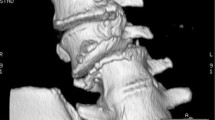Abstract
Surgical correction of fixed thoracolumbar deformity is usually achieved by estimating the preoperatively planned correction angles during surgery and is therefore prone to inaccuracy. This is particularly problematic in biplanar deformities. To overcome these difficulties, 3D model for planning, preparation, and simulation of an asymmetric pedicle subtraction osteotomy (aPSO) was printed and used to realign coronal and sagittal balance in case of rigid degenerative kyphoscoliosis. A 59-year-old woman presented with severe back pain and spinal claudication and was diagnosed with a rigid kyphoscoliosis with multilevel spinal stenosis. Spino-pelvic parameters were measured preoperatively (pelvic incidence 47° [PI], lumbar lordosis 18° [LL]; pelvic tilt 42° [PT], T1 pelvic angle 40° [TPA], Cobb angle 33°, sagittal vertical axis 10.5 cm [SVA]). To aid the complex deformity in the sagittal and coronal plane, a 1:1 3D model of the spine was printed according to the preoperative computed tomography (CT). With the use of a rebalancing software, the spine was prepared in vitro as a model for intraoperative realignment and the correction was preoperatively simulated. Surgery was accomplished according to the preoperative software-guided plan. Asymmetric pedicle subtraction osteotomy (aPSO) of L3 identical to the 3D model was performed. Additionally, a Smith-Peterson osteotomy of L4/5 with transforaminal lumbar interbody fusion (TLIF) and laminectomy of L2–S1 with pedicle screw instrumentation TH12–S1 was accomplished. Postoperative radiological parameters revealed good success (LL 40°, SVA 6 cm, PT 19°, TPA 22°, and a Cobb angle of 8°). Improvement of the Oswestry disability index (ODI) of 42 to 18, the visual analog scale (VAS) of 8 to 1, and walking distance 100 to 8000 m compared to preoperatively resulted at 24 months follow-up. The precise coronal and sagittal correction of a rigid degenerative kyphoscoliosis presents a major challenge. Asymmetric PSO is able to realign the thoracolumbar spine in both the coronal and sagittal planes. The creation of an in vitro 3D-printed model of a patient’s spinal deformity in combination with a software to calculate the correction angles facilitates preoperative planning and implementation of aPSO.




Similar content being viewed by others
References
Schwab F, Blondel B, Chay E, Demakakos J, Lenke L, Tropiano P et al (2015) The comprehensive anatomical spinal osteotomy classification. Neurosurgery 76(Suppl 1):S33–S41; discussion S41. doi:10.1227/01.neu.0000462076.73701.09
Bridwell KH (2006) Decision making regarding Smith-Petersen vs. pedicle subtraction osteotomy vs. vertebral column resection for spinal deformity. Spine (Phila Pa 1976) 31:S171–S178. doi:10.1097/01.brs.0000231963.72810.38
Schwab F, Patel A, Ungar B, Farcy JP, Lafage V (2010) Adult spinal deformity-postoperative standing imbalance: how much can you tolerate? An overview of key parameters in assessing alignment and planning corrective surgery. Spine (Phila Pa 1976) 35:2224–2231. doi:10.1097/BRS.0b013e3181ee6bd4
Obeid I, Boissière L, Vital JM, Bourghli A (2015) Osteotomy of the spine for multifocal deformities. Eur Spine J 24(Suppl 1):S83–S92. doi:10.1007/s00586-014-3660-9
Roussouly P, Gollogly S, Berthonnaud E, Dimnet J (2005) Classification of the normal variation in the sagittal alignment of the human lumbar spine and pelvis in the standing position. Spine (Phila Pa 1976) 30:346–353
Kothbauer K, Schmid UD, Seiler RW, Eisner W (1994) Intraoperative motor and sensory monitoring of the cauda equina. Neurosurgery 34:702–707 discussion 707
James HE, Mulcahy JJ, Walsh JW, Kaplan GW (1979) Use of anal sphincter electromyography during operations on the conus medullaris and sacral nerve roots. Neurosurgery 4:521–523
Barrey C, Perrin G, Michel F, Vital JM, Obeid I (2014) Pedicle subtraction osteotomy in the lumbar spine: indications, technical aspects, results and complications. Eur J Orthop Surg Traumatol 24(Suppl 1):S21–S30. doi:10.1007/s00590-014-1470-8
Protopsaltis T, Schwab F, Bronsard N, Smith JS, Klineberg E, Mundis G et al (2014) TheT1 pelvic angle, a novel radiographic measure of global sagittal deformity, accounts for both spinal inclination and pelvic tilt and correlates with health-related quality of life. J Bone Joint Surg Am 96:1631–1640. doi:10.2106/JBJS.M.01459
Author information
Authors and Affiliations
Corresponding author
Ethics declarations
Funding
The study did not receive any external funding.
Disclosure of potential conflicts of interest
None of the authors has any conflict of interest in connection with the study.
Ethical approval
According to the local institutional review board, for this type of retrospective study ethics approval is not required.
Informed consent
According to the local institutional review board, for this type of retrospective study informed consent is not required.
Rights and permissions
About this article
Cite this article
Girod, PP., Hartmann, S., Kavakebi, P. et al. Asymmetric pedicle subtractionosteotomy (aPSO) guided by a 3D-printed model to correct a combined fixed sagittal and coronal imbalance. Neurosurg Rev 40, 689–693 (2017). https://doi.org/10.1007/s10143-017-0882-4
Received:
Revised:
Accepted:
Published:
Issue Date:
DOI: https://doi.org/10.1007/s10143-017-0882-4




